Research on Grain Refinement in Hypoeutectic Al-Si Alloy during Solidification under an Alternating Electric Current Pulse
Abstract
:1. Introduction
2. Experimental Procedures
3. Results and Discussion
4. Conclusions
Author Contributions
Funding
Acknowledgments
Conflicts of Interest
References
- Wang, T.M.; Zhu, J.; Kang, H.J.; Chen, Z.N.; Fu, Y.N.; Huang, W.X.; Xiao, T.Q. In situ synchrotron X-ray imaging on morphological evolution of dendrites in Sn-Bi hypoeutectic alloy under electric currents. Appl. Phys. A 2014, 117, 1059–1066. [Google Scholar] [CrossRef]
- Conrad, H. Influence of an electric or magnetic field on the liquid-solid transformation in materials and on the microstructure of the solid. Mater. Sci. Eng. A 2000, 287, 205–212. [Google Scholar] [CrossRef]
- Zhang, Y.H.; Cheng, X.R.; Zhong, H.G.; Xu, Z.S.; Li, L.J.; Gong, Y.Y.; Miao, X.C.; Song, C.J.; Zhai, Q.J. Comparative Study on the Grain Refinement of Al-Si Alloy Solidified under the Impact of Pulsed Electric Current and Travelling Magnetic Field. Metals 2016, 6, 170. [Google Scholar] [CrossRef]
- Zhang, Y.H.; Ye, C.Y.; Xu, Y.Y.; Zhong, H.G.; Chen, X.R.; Miao, X.C.; Song, C.J.; Zhai, Q.J. Influence of growth velocity on the separation of primary silicon in solidified Al-Si hypereutectic alloy driven by a pulsed electric current. Metals 2017, 7, 184. [Google Scholar] [CrossRef]
- Misra, A.K. A novel solidification technique of metals and alloys under the influence of applied potential. Metall. Trans. A 1985, 16, 1354–1355. [Google Scholar] [CrossRef]
- Vashchenko, K.I.; Chernega, D.F.; Vorobev, S.L.; Lysenko, N.I.; Yakovchuk, Y.E. Effect of electric current on the solidification of cast iron. Met. Sci. Heat Treat. 1974, 16, 261–265. [Google Scholar] [CrossRef]
- Eskin, G.I. Broad prospects for commercial application of the ultrasonic (cavitation) melt treatment of light alloys. Ultrason. Sonochem. 2001, 8, 319–325. [Google Scholar] [CrossRef]
- Zhai, W.; Hong, Z.Y.; Wen, X.L.; Geng, D.L.; Wei, B. Microstructural characteristics and mechanical properties of peritectic Cu-Sn alloy solidified within ultrasonic field. Mater. Des. 2015, 72, 43–50. [Google Scholar] [CrossRef]
- Kotadia, H.R.; Das, A. Modification of solidification microstructure in hypo- and hyper-eutectic Al-Si alloys under high-intensity ultrasonic irradiation. J. Alloy Compd. 2015, 620, 1–4. [Google Scholar] [CrossRef]
- Haghayeghi, R.; Kapranos, P. Solidification of Pb-Sn alloys under ultrasonic field. Mater. Lett. 2014, 126, 244–248. [Google Scholar] [CrossRef]
- Li, M.J.; Tamura, T.; Miwa, K. Controlling microstructures of AZ31 magnesium alloys by an electromagnetic vibration technique during solidification: From experimental observation to theoretical understanding. Acta Mater. 2007, 55, 4635–4643. [Google Scholar] [CrossRef]
- Jiang, W.Y.; Yu, W.Z.; Li, J.; You, Z.X.; Li, C.M.; Lv, X.W. Segregation and Morphological Evolution of Si Phase during Electromagnetic Directional Solidification of Hypereutectic Al-Si Alloys. Materials 2019, 12, 10. [Google Scholar] [CrossRef]
- Kaldre, I.; Fautrelle, Y.; Etay, J.; Bojarevics, A.; Buligins, L. Influence on the macrosegregation of binary metallic alloys by thermoelectromagnetic convection and electromagnetic stirring combination. J. Cryst. Growth 2014, 402, 230–233. [Google Scholar] [CrossRef]
- Xing, H.; Ankit, K.; Dong, X.L.; Chen, H.M.; Jin, K.X. Growth direction selection of tilted dendritic arrays in directional solidification over a wide range of pulling velocity: A phase-field study. Int. J. Heat Mass Trans. 2018, 117, 1107–1114. [Google Scholar] [CrossRef]
- Yu, W.Z.; Ma, W.H.; Lv, G.Q.; Xue, H.Y.; Li, S.Y.; Dai, Y.N. Effect of electromagnetic stirring on the enrichment of primary silicon from Al-Si melt. J. Cryst. Growth 2014, 405, 23–28. [Google Scholar] [CrossRef]
- Nakada, M.; Shiohara, Y.; Flemings, M.C. Modification of solidification structures by pulse electric discharging. ISIJ Int. 1990, 30, 27–33. [Google Scholar] [CrossRef]
- Barnak, J.P.; Sprecher, A.F.; Conrad, H. Colony (grain) size reduction in eutectic Pb-Sn castings by electroplusing. Scr. Metall. Mater. 1995, 32, 879–884. [Google Scholar] [CrossRef]
- Liao, X.L.; Zhai, Q.J.; Luo, J.; Chen, W.J.; Gong, Y.Y. Refining mechanism of the electric current pulse on the solidification structure of pure aluminum. Acta Mater. 2007, 55, 3103–3109. [Google Scholar] [CrossRef]
- Li, J.; Ma, J.H.; Gao, Y.L.; Zhai, Q.J. Research on solidification structure refinement of pure aluminum by electric current pulse with parallel electrodes. Mater. Sci. Eng. A 2008, 490, 452–456. [Google Scholar] [CrossRef]
- Räbiger, D.; Zhang, Y.H.; Galindo, V.; Franke, S.; Willers, B.; Eckert, S. The relevance of melt convection to grain refinement in Al-Si alloys solidified under the impact of electric currents. Acta Mater. 2014, 79, 327–338. [Google Scholar] [CrossRef]
- Zhang, Y.H.; Xu, Y.Y.; Ye, C.Y.; Sheng, C.; Sun, J.; Wang, G.; Miao, X.C.; Song, C.J.; Zhai, Q.J. Relevance of electrical current distribution to the forced flow and grain refinement in solidified Al-Si hypoeutectic alloy. Sci. Rep. 2018, 8, 3242. [Google Scholar] [CrossRef]
- Zhang, L.M.; Liu, H.N.; Li, N.; Wang, J.; Zhang, R.; Xing, H.; Song, K.K. The relevance of forced melt flow to grain refinement in pure aluminum under a low-frequency alternating current pulse. J. Mater. Res. 2016, 31, 396–404. [Google Scholar] [CrossRef]
- Zhang, Y.H.; Räbiger, D.; Eckert, S. Solidification of pure aluminium affected by a pulsed electrical field and electromagnetic stirring. J. Mater. Sci. 2016, 51, 2153–2159. [Google Scholar] [CrossRef]
- Li, N.; Zhang, R.; Zhang, L.M.; Xing, H.; Yin, P.F.; Wu, Y.Y. Study on gain refinement mechanism of hypoeutectic Al-7%Si alloy under low voltage alternating current pulse. Acta Metall. Sin. 2017, 53, 192–200. [Google Scholar]
- Gandin, C.-A. Experimental study of the transition from constrained to unconstrained growth during directional solidification. ISIJ Int. 2000, 40, 971–979. [Google Scholar] [CrossRef]
- Willers, B.; Eckert, S.; Michel, U.; Haase, I.; Zouhar, G. The columnar-to-equiaxed transition in Pb-Sn alloys affected by electromagnetically driven convection. Mater. Sci. Eng. A 2005, 402, 55–65. [Google Scholar] [CrossRef]
- Peres, M.D.; Siqueira, C.A.; Garcia, A. Macrostructural and microstructural development in Al-Si alloys directionally solidified under unsteady-state conditions. J. Alloy. Compd. 2004, 381, 168–181. [Google Scholar] [CrossRef]
- Qi, J.G.; Wang, J.Z.; He, L.J.; Zhao, Z.F.; Du, H.L. An investigation for structure transformation in electric pulse modified liquid aluminum. Phys. B Condens. Matter 2011, 406, 846–849. [Google Scholar] [CrossRef]
- Zhang, L.M.; Zhang, R.; Chen, W.J.; Wu, Y.W.; Li, N. Effect of a novel low-voltage alternating current pulse on solidification structure of Al-7Si-0.52Mg alloy. Adv. Mater. Res. 2012, 482–484, 1431–1435. [Google Scholar] [CrossRef]
- Gong, Y.Y.; Luo, J.; Jing, J.X.; Xia, Z.Q.; Zhai, Q.J. Structure refinement of pure aluminum by pulse magneto-oscillation. Mater. Sci. Eng. A 2008, 497, 147–152. [Google Scholar] [CrossRef]
- Qin, R.S.; Samuel, E.I.; Bhowmik, A. Electropulse-induced cementite nanoparticle formation in deformed pearlitic steels. J. Mater. Sci. 2011, 46, 2838–2842. [Google Scholar] [CrossRef]
- Wang, X.L.; Wang, Y.B.; Wang, Y.M.; Wang, B.Q.; Guo, J.D. Oriented nanotwins induced by electric current pulses in Cu-Zn alloy. Appl. Phys. Lett. 2007, 91, 163112. [Google Scholar] [CrossRef]
- Zhang, X.F.; Lu, W.J.; Qin, R.S. Removal of MnS inclusions in molten steel using electropulsing. Scr. Mater. 2013, 69, 453–456. [Google Scholar] [CrossRef]
- Zhang, X.F.; Qin, R.S. Electric current-driven migration of electrically neutral particles in liquids. Appl. Phys. Lett. 2014, 104, 114106. [Google Scholar] [CrossRef]
- Zhang, X.F.; Qin, R.S. Controlled motion of electrically neutral microparticles by pulsed direct current. Sci. Rep. 2015, 5, 10162. [Google Scholar] [CrossRef]
- Sklyarchuk, V.; Plevachuk, Y.; Yakymovych, A.; Eckert, S.; Gerbeth, G.; Eigenfeld, K. Structure sensitive properties of liquid Al-Si alloys. Int. J. Thermophys. 2009, 30, 1400–1410. [Google Scholar] [CrossRef]
- Brandt, R.; Neuer, G. Electrical resistivity and thermal conductivity of pure aluminum and aluminum alloys up to and above the melting temperature. Int. J. Thermophys. 2007, 28, 1429–1446. [Google Scholar] [CrossRef]
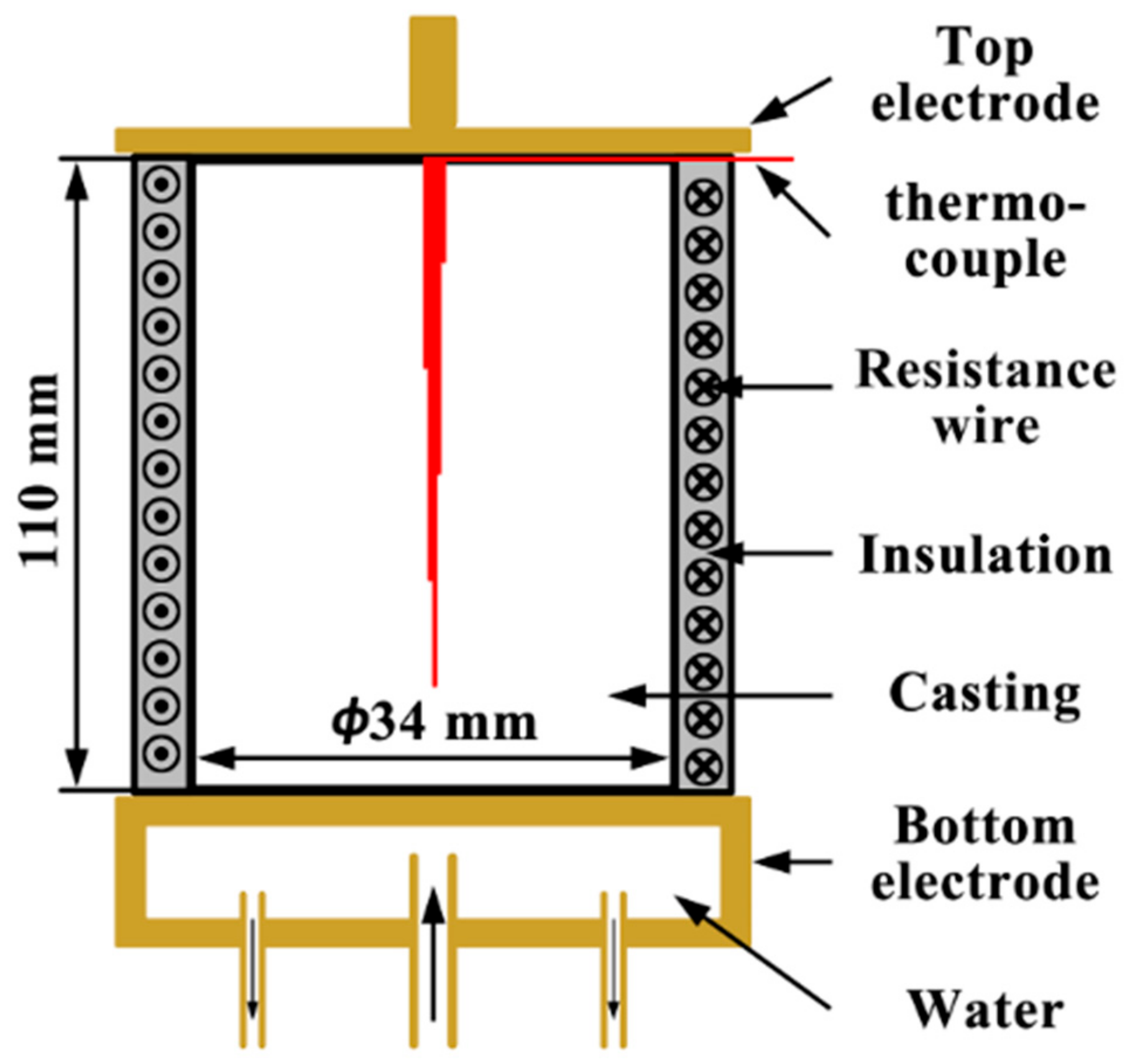
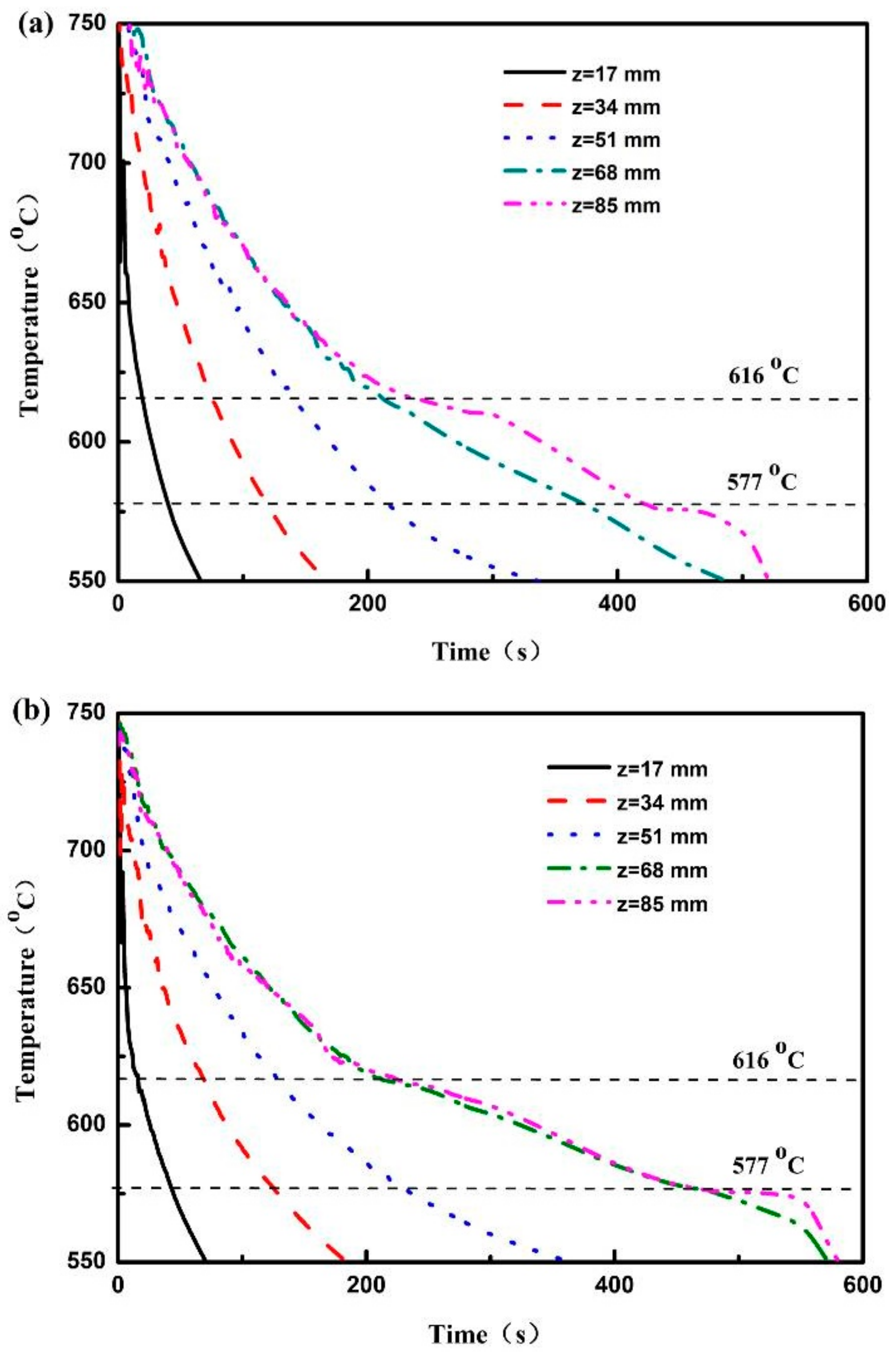
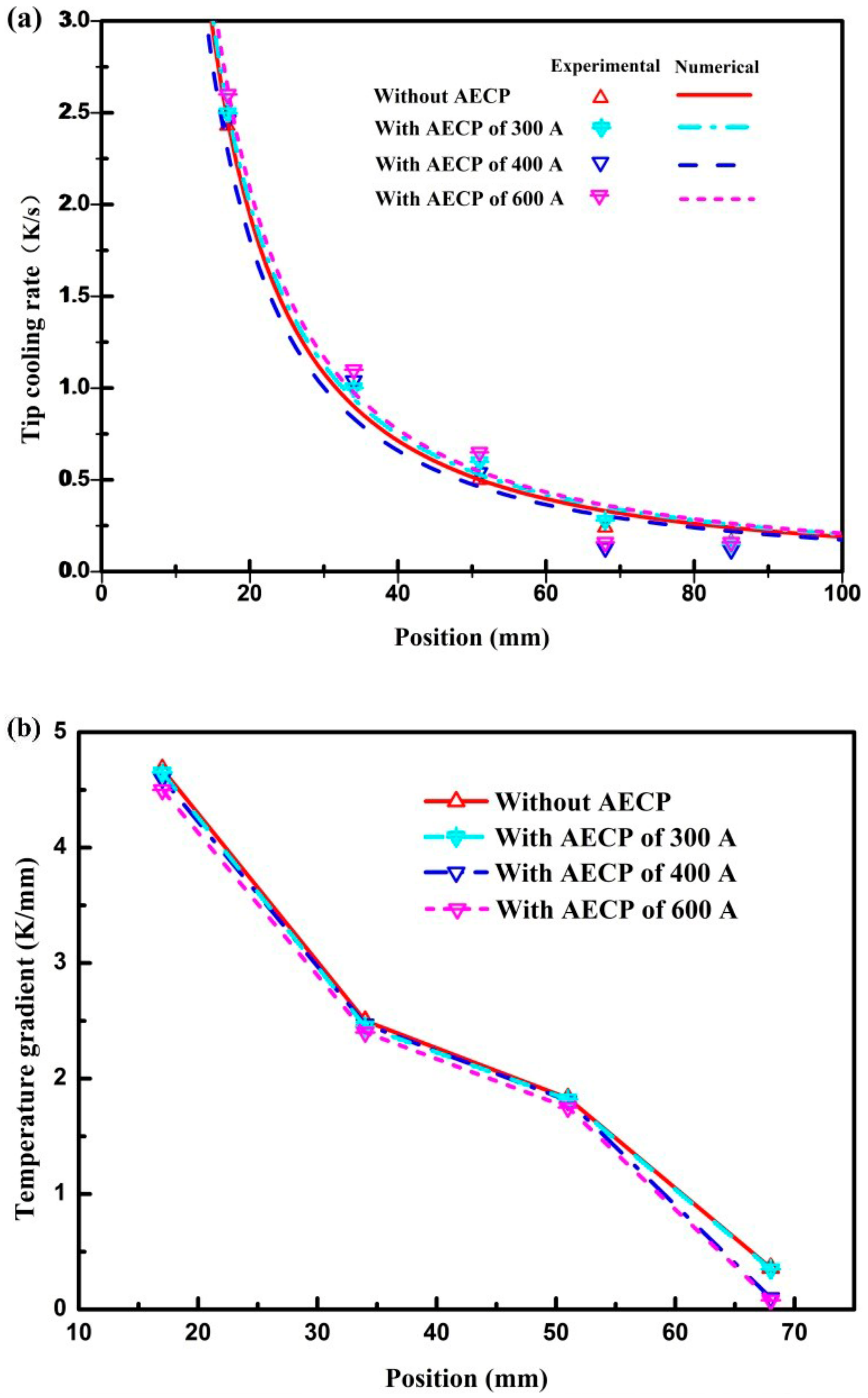
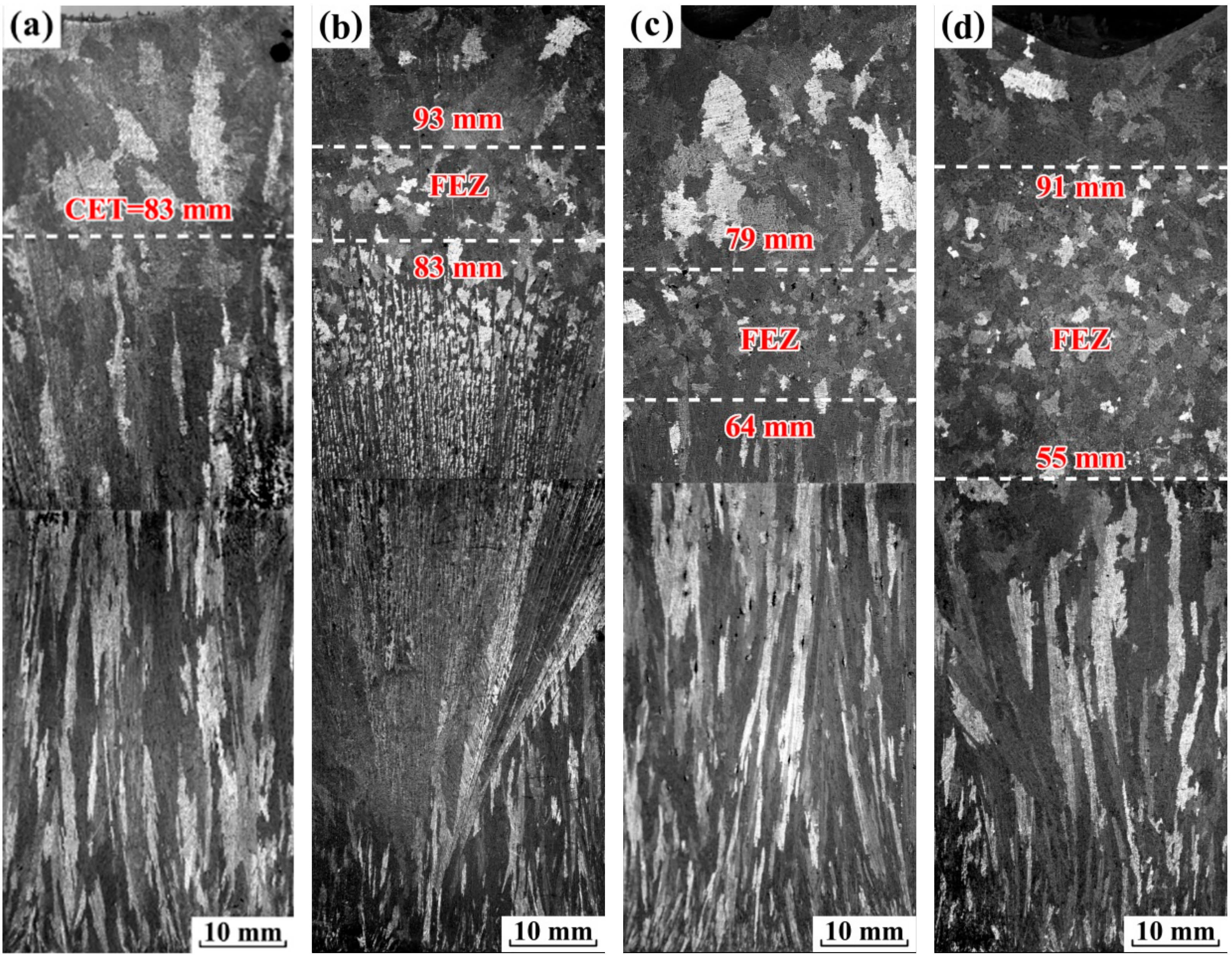
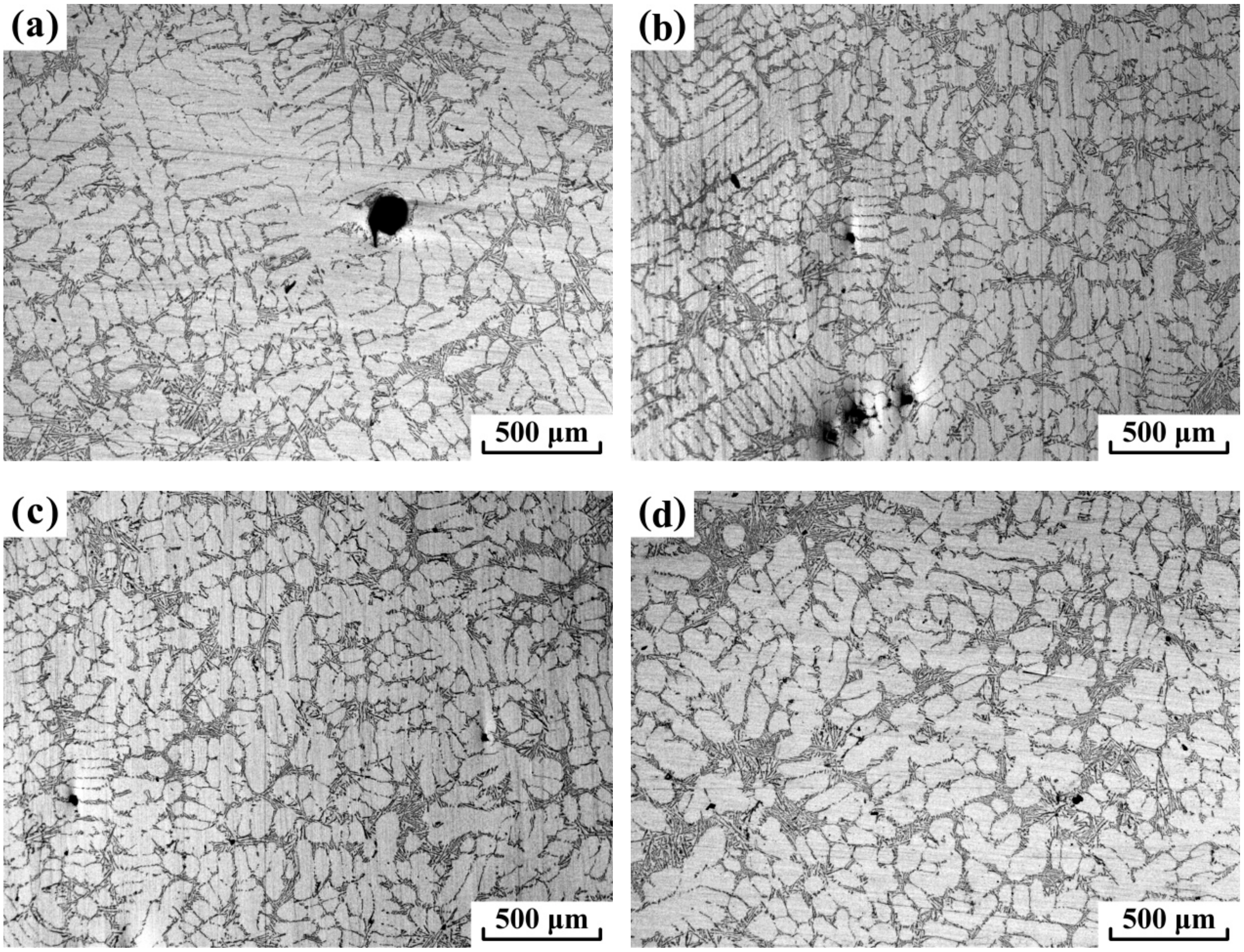
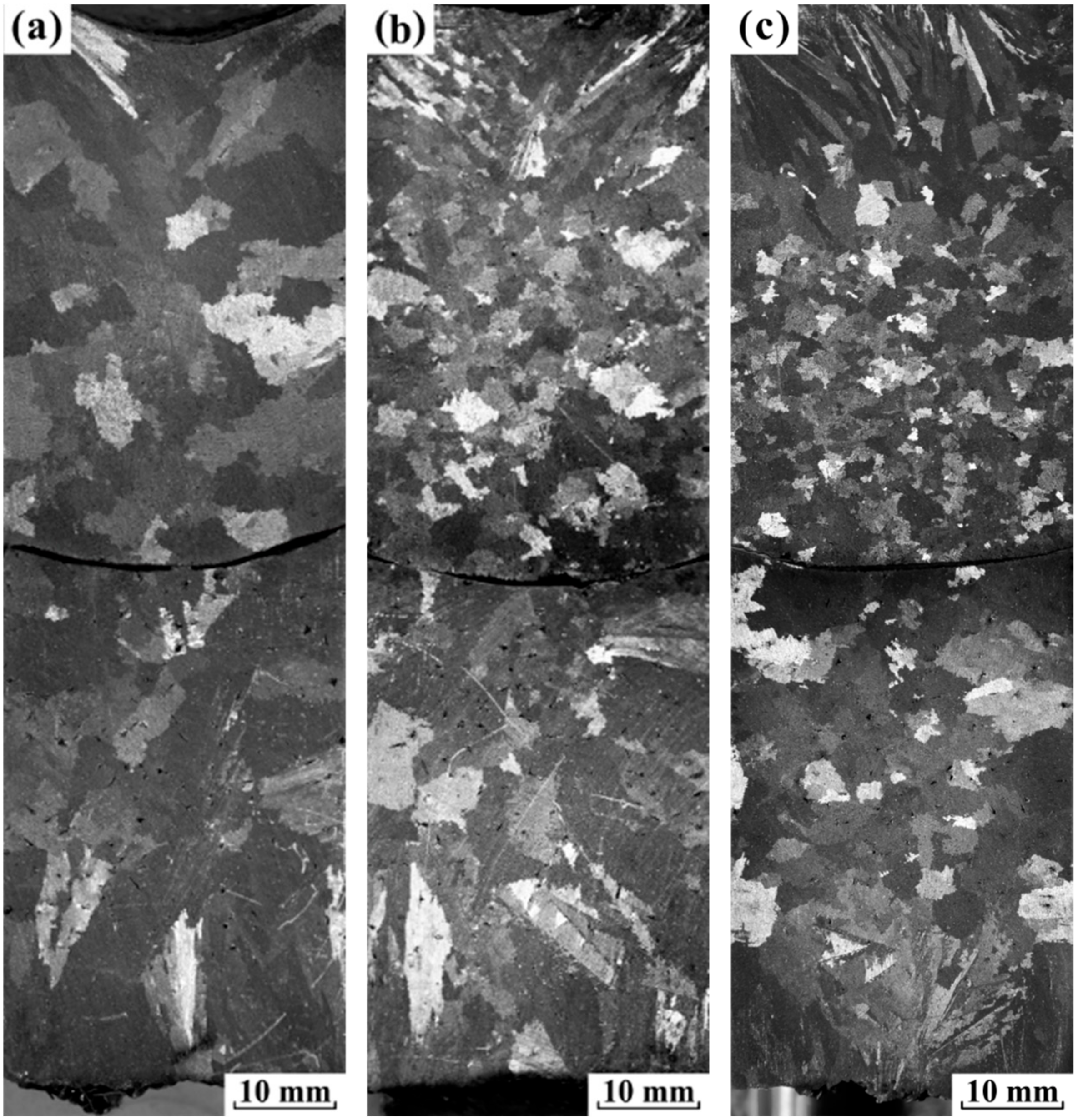
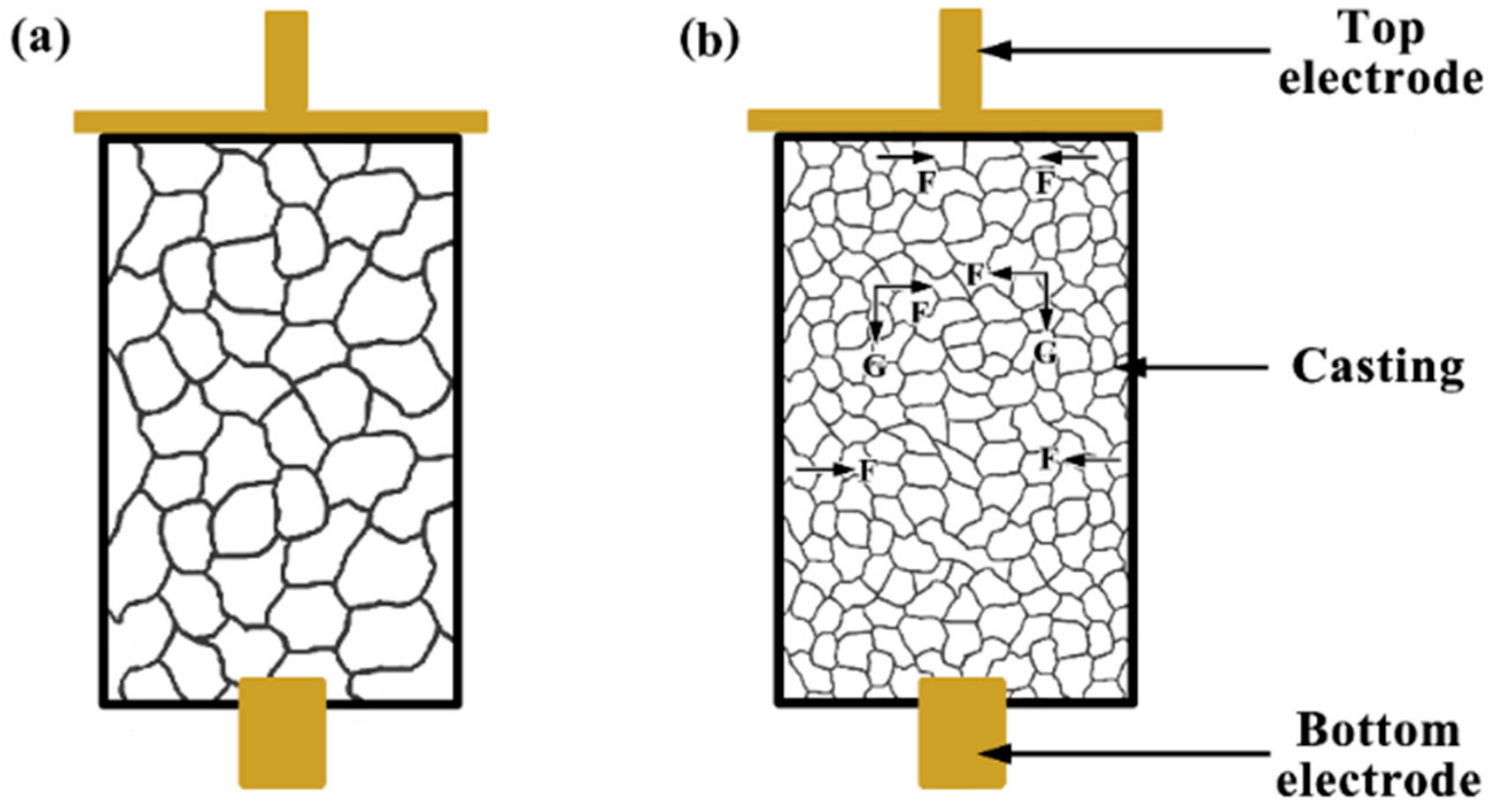
© 2019 by the authors. Licensee MDPI, Basel, Switzerland. This article is an open access article distributed under the terms and conditions of the Creative Commons Attribution (CC BY) license (http://creativecommons.org/licenses/by/4.0/).
Share and Cite
Li, N.; Zhang, L.; Zhang, R.; Yin, P.; Xing, H.; Wu, H. Research on Grain Refinement in Hypoeutectic Al-Si Alloy during Solidification under an Alternating Electric Current Pulse. Metals 2019, 9, 571. https://doi.org/10.3390/met9050571
Li N, Zhang L, Zhang R, Yin P, Xing H, Wu H. Research on Grain Refinement in Hypoeutectic Al-Si Alloy during Solidification under an Alternating Electric Current Pulse. Metals. 2019; 9(5):571. https://doi.org/10.3390/met9050571
Chicago/Turabian StyleLi, Ning, Limin Zhang, Rong Zhang, Pengfei Yin, Hui Xing, and Hongjing Wu. 2019. "Research on Grain Refinement in Hypoeutectic Al-Si Alloy during Solidification under an Alternating Electric Current Pulse" Metals 9, no. 5: 571. https://doi.org/10.3390/met9050571
APA StyleLi, N., Zhang, L., Zhang, R., Yin, P., Xing, H., & Wu, H. (2019). Research on Grain Refinement in Hypoeutectic Al-Si Alloy during Solidification under an Alternating Electric Current Pulse. Metals, 9(5), 571. https://doi.org/10.3390/met9050571







